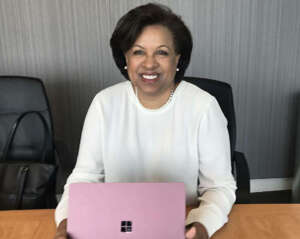
Hubbard Radio Washington DC, LLC. All rights reserved. This website is not intended for users located within the European Economic Area.
Hubbard Radio Washington DC, LLC. All rights reserved. This website is not intended for users located within the European Economic Area.
Toni Townes-Whitley, president for U.S. Regulated Industries at Microsoft, said industry is shifting away from providing software or products to finding more re...
Views from the Corner Office is a new show designed to talk to the private sector leaders that influence and impact the federal market. The goal of this monthly discussion is for federal executives, lawmakers and other industry experts to gain insights and a better understanding into the trends, the challenges and the evaluation of the technology, acquisition and leadership in the federal market by the executives who lead the federal practices of government contractors.
Toni Townes-Whitley, the president, U.S. Regulated Industries at Microsoft, sat down with Federal News Network Executive Editor Jason Miller at Microsoft’s offices in Washington, D.C.
Here are some excerpts from that discussion.

Jason Miller: Is it a good time to be a federal contractor?
Toni Townes-Whitley: It’s a good time to be a federal contractor. I think it’s a better time to be a consultant/adviser in many ways to be a partner to the federal government. I think the old terms of contractor and vendor are shifting, and if I look at Microsoft’s engagement, I would say that would be the “from-to” statement. We have been a vendor, sometimes someone’s email provider. We have a brand that we’ve had previously that is changing significantly in the federal market. We’re engaging in partnership. We’re underpinning mission critical systems. We’re advising on artificial intelligence and its uses. We are talking about the future of mission readiness. We are training and engaging in ways that we have not done before. And quite frankly, we’re doing that in very direct ways, not through intermediaries or resellers of some sort of product.
JM: It’s an interesting concept moving from providing something to advising. Talk a little bit about how that happened over the last three, five or seven years, not just for Microsoft, but I think you’re seeing this across several different contractors, industry partners.
TTW: The entire industry and technology itself has made a shift from just software development, which is an important and critical part of innovation and continues to be from Microsoft, to building platforms and capabilities that are so robust. They affect every aspect of the mission, not just the IT operation. In the government space, we’ve talked about mission critical systems and capabilities. So we talk about how we engage with the Department of Veterans Affairs. It’s not only their legacy systems and bringing the cost down of those legacy systems, which we do focus on, but it’s also how do we actually address the veteran. How do we put online tools and capabilities in place that the veteran has a different experience, like access to care, which we were able to build for the VA where the veteran can choose and use predictive kinds of capabilities to determine where’s the best place to get support and medical services based on wait time and facility? That’s the shift that everyone is making in technology. I think Microsoft is showing up, I hope, and I’ve heard from our customers that we’re showing up much more relevant to the mission and much more in the language of our customers.
JM: Discuss this idea of edge computing. Usually when we hear about edge computing, you hear about the Defense Department wanting to push capabilities out to the warfighter in restricted environments. But this concept of edge computing is really moving outside of DoD and to civilian agencies. What are you seeing around that?
TTW: Obviously, when we think about frontline workers and the ability to equip frontline workers we think of a Census worker that’s collecting important information. It’s not just about the device that’s there, but it’s about that Census worker in any environment having the ability to have full time, fully accessible, real-time connectivity and full computing capability in any spot in the U.S. That’s similar to a forward-deployed soldier. For the Defense Department being able to fully connect and have predicted cognitive capability in any environment whether disconnected or fully connected environment is important. We think about it for the Postal Service around their fleet — one of the largest fleets in the U.S. that touches every American five to six days a week — and the fleet has sensors and information. What could we reimagine in terms of a new Postal Service using all that data? This is the kind of conversations we are having. And all of that comes with this idea of bringing full cloud capability, full computing capability to the edge.
Related Stories
JM: You mentioned earlier those three dreaded words: Other transaction authority. Discuss your view of OTAs as Microsoft has been a part of several big ones including a big deal for enterprise-IT-as-a-service with the Air Force.
TTW: We should look at OTAs and say, “What is the rationale for why the government leverages an OTA?” Really what we found with Microsoft is where we’ve been selected has been where we’re bringing a commercial capability that generally doesn’t sit on our inventory or our price list, it’s a capability that’s been incubated or innovated. I think about not only network-as-a-service, as you’ve mentioned, that we’ve done with the Air Force and now with the Army. But, even recently with the Army with the integrated visual system that we provide that is a synthetic training environment for the Army. This is the opportunity for a soldier with mixed reality putting on a head piece that brings together a physical and a digital experience to train in an environment of sea, land and air. It’s a unique opportunity that we believe will drive better decision making in the battlefield and will reduce casualties. That was something that the Army decided that this is a critical capability that exists in the commercial market. This is something that the Army and all of DoD should take advantage of. Let’s try it. And let’s start to sort of put it in theater and start to see if this works. And then perhaps it’ll move down a different procurement path. So I think the question around OTAs become, why does the government use it? When does the government use it?
And can we all agree that currently, it is still pretty difficult to bring the newest innovations into a government procurement in ways that help the government understand how to procure. What’s the maturity of the technology? What’s the underlying sort of technical source code? How do we ensure that the government knows the best use? Are there any ethical considerations with the technology? I think it’s really hard still in the RFI-RFP process to get that across, which is why I think OTAs are being used more and more.
JM: There’s a little irony that OTAs are supposed to bring in the innovative non-traditional contractors. And then when the awards go to AT&T or Microsoft or Verizon, you’re going, who’s the nontraditional there and who are their partners who are nontraditional contractors?
TTW: I can say, does Microsoft have partners that are nontraditional contractors working on that program? Not generally. I would not correlate the two that that was the rationale for our response. I think what I hear is when the capability being procured is fairly standard and has a track record, and this is the newest iteration, why go to that procurement approach when there are many others that exist? I think that’s a fair question. I probably can’t respond on behalf of DoD.
JM: Are OTAs a good or a bad trend?
TTW: I don’t think we have a sample large enough that I would say this is a trend yet. I mean, we’ve obviously seen them. We’ve seen them go to Microsoft, but also to other organizations. I think the broader question is going to be in the portfolio procurement opportunities from sole source to fully competitive procurements to OTA will we see that pie shift? Is it shifting because of frustration with existing players or procurement vehicles? Is it shifting because of the desire to move and accelerate in a faster pace? Is it shifting because, I would argue, the newest technology that’s been procured requires a level of understanding that, quite frankly the procurement officials don’t have but really need to know how to procure.
JM: Tell me something about yourself outside of the federal market and your day-to-day work.
TTW: I was a high school all-American basketball player, played in college at Princeton and I had a tryout with the WNBA. I think the other thing I’ve been working on screenplay for about five years now, so I do a lot of writing both fiction and nonfiction. And I’ve been working on screenplays and go to boot camps to learn about screenplays, I’m fascinated with movies and film. And then, I love travel — as the kids will say, weird travel or odd travel. We don’t just do the basic stuff. We got to go and be the most indigenous people in the world. And so we’ll call it eco-travel. It’s cool now, but it wasn’t when I started. So now we just say we’re traveling.
Copyright © 2024 Federal News Network. All rights reserved. This website is not intended for users located within the European Economic Area.
Jason Miller is executive editor of Federal News Network and directs news coverage on the people, policy and programs of the federal government.
Follow @jmillerWFED
